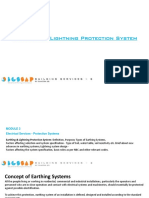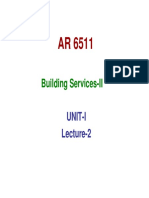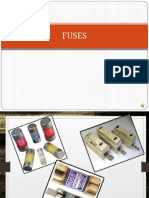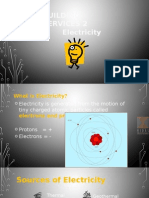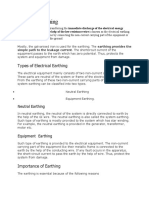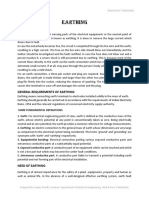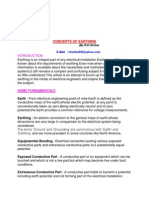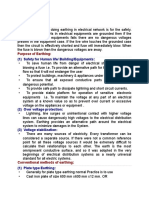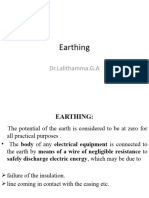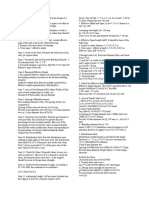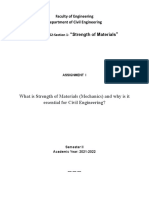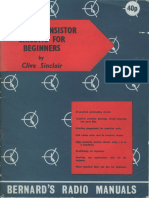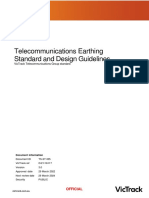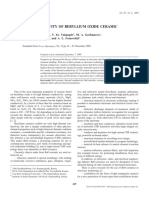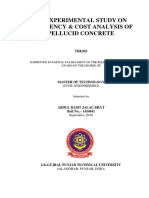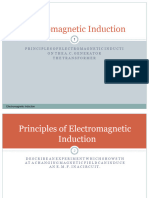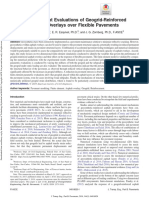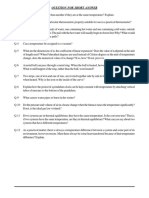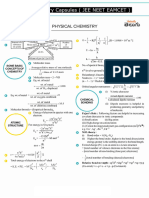AURORA HIGHER EDUCATION AND RESEARCH ACADEMY
Deemed-to-be University
(Estd. u/s. 03 of UGC Act 1956)
Uppal, Hyderabad, Telangana - 500 098.
www.aurora.edu.in
Department of Electrical and Electronics Engineering
Course Name:
Year:
BASIC Corse Code:
F. Y. B. Tech
ELECTRICAL EE101
(AIML/CSE(DS))
ENGINEERING
Dr. Rajashekher Koyyeda
M. Tech ,Ph. D
Associate Professor 1
� Module 07: Earthling and protection
Equipment
Need of good Earthing, Types of Earthing
Methods of Earthing Plate Earthing and Pipe Earthing
Construction, working and features Fuse and MCB.
No of Lectures : 03 hrs
2
� Module 07: Earthling and protection Equipment
Electrical Earthing:
Definition: The process of transferring the immediate discharge of the
electrical energy directly to the earth by the help of the low
resistance wire is known as the electrical earthing.
The electrical earthing is done by connecting the non-current carrying
part of the equipment or neutral of supply system to the ground
Mostly, the galvanized iron is used for the earthing.
The earthing provides the simple path to the leakage current.
The short circuit current of the equipment passes to the earth which has
zero potential. Thus, protects the system and equipment from damage.
3
� Module 07: Earthling and protection Equipment
Need of good earthing:
To save human life from danger of electrical shock or death by blowing a
fuse i.e. to provide an alternative path for the fault current to flow so that
it will not endanger the user.
To protect buildings, machinery & appliances under fault conditions ie. to
ensure that all exposed conductive parts do not reach a dangerous
potential. To provide safe path to dissipate lightning and short circuit
currents.
To provide stable platform for operation of sensitive electronic
equipment's i.e. To maintain the voltage at any part of an electrical
system at a known value so as to prevent over current or excessive
voltage on the appliances or equipment.
To provide protection against static electricity from friction
4
� Module 07: Earthling and protection Equipment
Types of Electrical Earthing :
The electrical equipment mainly consists of two non-current carrying parts.
These parts are neutral of the system or frame of the electrical equipment.
From the earthing of these two non-current carrying parts of the electrical
system earthing can be classified into two types.
1.Neutral Earthing
2.Equipment Earthing.
1.Neutral Earthing:
In neutral earthing, the neutral of the system is directly connected to
earth by the help of the GI wire. The neutral earthing is also called the
system earthing.
Such type of earthing is mostly provided to the system which has star
winding. For example, the neutral earthing is provided in the generator,
transformer, motor etc.
5
� Module 07: Earthling and protection Equipment
Types of Electrical Earthing :
2.Equipment Earthing:
Such type of earthing is provided to the electrical equipment. The non-
current carrying part of the equipment like their metallic frame is connected
to the earth by the help of the conducting wire. If any fault occurs in the
apparatus, the short-circuit current to pass the earth by the help of wire.
Thus, protect the system from damage.
Importance of Earthing:
The earthing is essential because of the following reasons
The earthing protects the personnel from the short circuit current.
The earthing provides the easiest path to the flow of short circuit current
even after the failure of the insulation.
The earthing protects the apparatus and personnel from the high voltage
surges and lightning discharge.
6
�Module 07: Earthling and protection Equipment
7
� Module 07: Earthling and protection Equipment
Methods of Earthing
1. Pipe Earthing:
This is the most common and best
system of earthing as compared to
other systems suitable for the same
earth and moisture conditions.
In this method the galvanized steel
and perforated pipe of approved
length and diameter in place upright
in a permanently wet soil, as shown
In fig.
The size of the pipe depends
upon the current to be carried and type of soil.
Normally, the size of the pipe uses for earthing is of diameter 40 mm and
2.5 meters in length for ordinary soil or of greater length in case of dry
and rocky soil.
8
� Module 07: Earthling and protection Equipment
1. Pipe Earthing:
The depth at which the pipe must be buried depends on the moistures of the
ground.
The pipe is placed at 3.75 meters. The bottom of the pipe is surrounded by
small pieces of coke or charcoal at a distance of about 15 cm. Alternate layers
of coke and salt are used to increase the effective area of the earth and to
decrease the earth resistance respectively.
Another pipe of 19 mm diameter and minimum length 1.25 meters is
connected at the top of GI pipe through reducing socket.
During summer the moisture in the soil decreases, which causes an increase
in earth resistance. So a cement concrete work is done to keep the water
arrangement accessible, and in summer to have an effective earth, 3 or 4
buckets of water are put through the funnel connected to 19 mm diameter
pipe, which is further connected to GI pipe.
The earth wire either GI or a strip of GI wire of sufficient cross section to carry
faulty current safely is carried in a GI pipe of diameter 12 mm at a depth of
9
about 60cm from the ground
� Module 07: Earthling and protection Equipment
2. Plate Earthing
In Plate Earthing an earthing
plate either of copper of dimension
60cm×60cm×3m of galvanized
iron of dimensions
60 cm× 60 cm×6 mm is buried into
the ground with its face vertical at
a depth of not less than 3 meters from
ground level.
The earth plate is inserted into auxiliary
layers of coke and salt for a minimum
thickness of 15 cm. The earth wire
(GI or copper wire) is tightly bolted to
an earth plate with the help of nut or bolt. The copper plate and copper wire are
usually not employed for grounding purposes because of their higher cost.
10
� Module 07: Earthling and protection Equipment
Fuse:
Function :The fuse is the current interrupting devices which break or open
the circuit by fusing the element and thus remove the faulty device from the
main supply circuit.
Types of Fuses:
11
� Module 07: Earthling and protection Equipment
HRC Fuse:
Definition: HRC fuse (high rupturing capacity fuse) is one kind of fuse, where
the fuse wire carries a short circuit current in a set period. If the fault occurs in
the circuit then it blows off. The HRC fuse is made with glass otherwise some
other kind of chemical compound.
Working Principle of HRC Fuse
In normal conditions, the flow of current through the fuse doesn’t provide
sufficient energy to soften the element. If the huge current flows through the
fuse then it melts the element of the fuse before the fault current achieves
the climax.
When the fuse is in an overload condition, then the element of the fuse will
not blow-off however if this condition exists for an extended period, then the
material like Eutectic will dissolve & break the element of the fuse. When the
fuse is in short circuit condition, then the thin parts of the fuse element is less
area will dissolve quickly & will smash before the eutectic material. So this is
12
the reason to provide the limitations within the element of HRC Fuse
� Module 07: Earthling and protection Equipment
HRC Fuse:
Construction of HRC fuse
The construction of HRC fuse includes a material that has high heat resistant body
like ceramic. This ceramic body includes metal-end caps that are welded through
an element that carries silver-current
13
� Module 07: Earthling and protection Equipment
HRC Fuse:
Construction of HRC fuse
The internal space of the fuse body is filled by a filling powder material. Here the
material used in this is quartz, plaster of Paris, dust, marble, chalk, etc.
So this is the reason the flow of current cannot overheat. The generated heat
vaporizes the melted element.
The chemical reaction will occur between filling power and silver vapor to result
in high resistance material to help in reducing the arc within the fuse.
Generally, copper or silver is used as the fuse element because of its low
specific resistance. This element has normally two or more sections.
The fuse element normally has two or more sections that are connected through
tin joints.
The melting point of tin is 240 degree C that is lesser than silver’s melting point
of 980degree C. Thus the melting point of tin joints stops the fuse from getting
high temperatures in the short circuit and overload conditions.
14
� Module 07: Earthling and protection Equipment
MCB:
What is Miniature Circuit Breaker(MCB) ?
A miniature circuit breaker (MCB) is an electromagnetic device used to open
the circuit automatically once the current flowing throughout it exceeds the
set value. This MCB can also be switched ON & OFF like a normal switch if
required. These devices are rated at 220Volts for DC supply whereas, for AC
supply, it is rated at 240/415 including different short circuit current abilities.
MCBs perform various functions like local control switches, overload
protection devices for specific appliances or equipment & isolating switches
against errors
The working principle of MCB: is to detect the flow of current throughout
electrical circuits. If the flow of current goes beyond the highest set range,
then it will trip & interrupt the electrical circuit automatically.
15
� Module 07: Earthling and protection Equipment
Construction and Working and Operation of MCBs
Under normal working conditions, an MCB operates as a manual switch to turn
the circuit ON or OFF. In the event of an overload or short circuit, it automatically
trips to interrupt the current flow in the load circuit.
The visual indication of this trip can be observed by the automatic movement of
the operating knob to the OFF position. This automatic operation in an MCB can
be achieved in two ways, as we have seen in MCB construction: magnetic
tripping and thermal tripping.
16
� Module 07: Earthling and protection Equipment
Working and Operation of MCBs
Under overload conditions, the current passing through the bimetal causes
its temperature to rise. The heat generated within the bimetal itself is
sufficient to cause deflection due to the thermal expansion of metals. This
deflection further releases the trip latch, leading to the separation of
contacts.
In some MCBs, the magnetic field generated by the coil causes it to exert
pull on the bimetals, resulting in deflection that activates the tripping
mechanism.
.
17
� Module 07: Earthling and protection Equipment
Working and Operation of MCBs
Under short circuit or heavy overload conditions, the magnetic tripping
arrangement comes into play. During normal working conditions, the slug is
held in position by a light spring because the magnetic field generated by
the coil is not sufficient to attract the latch.
When a fault current flows, the magnetic field generated by the coil
becomes strong enough to overcome the spring force holding the slug in
position. Consequently, the slug moves and actuates the tripping
mechanism.
Most miniature circuit breakers implement a combination of both magnetic
and thermal tripping mechanisms. In both magnetic and thermal tripping
operations, an arc is formed when the contacts start separating. This arc is
then directed into arc splitter plates via an arc runner.
.
18
�Thank
You 19










